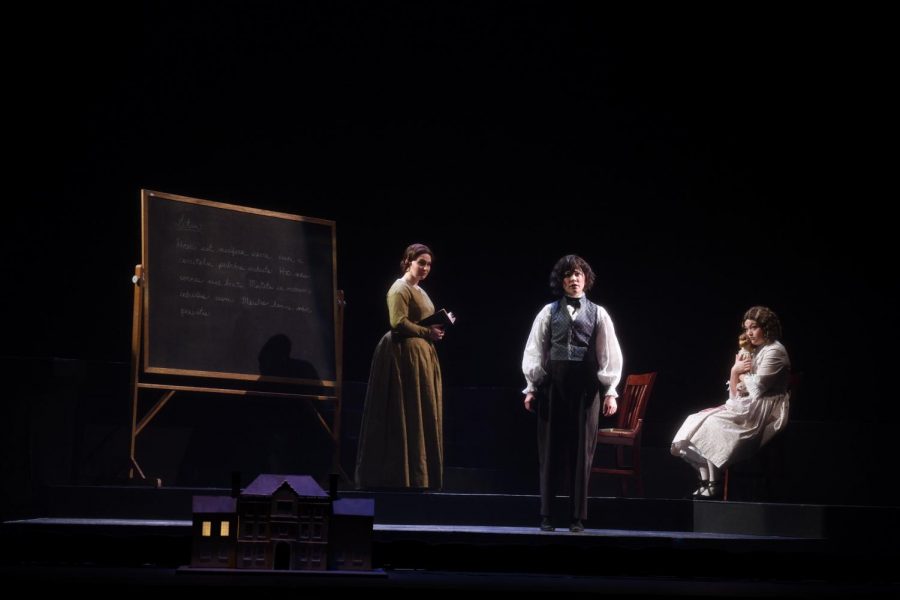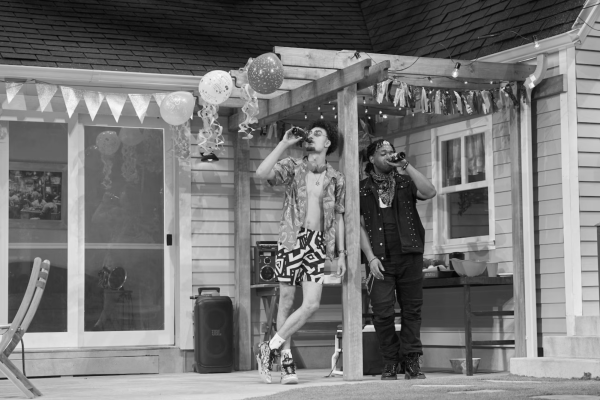“The Turn Of The Screw” Exemplifies Operatic Horror
The cast of the Oberlin Opera Theater’s production of The Turn Of The Screw performs Benjamin Britten’s creepy, contemporary ghost story opera.
Editor’s note: This article contains discussion of child sexual abuse.
“Beware of things that go bump in the night.”
According to Associate Professor of Opera Theater and Director Jonathon Field, this is the sentiment that audiences are likely to take away from Oberlin’s production of The Turn of the Screw. The chamber opera, Benjamin Britten and Myfanwy Piper’s chillingly creepy interpretation of the Henry James novella by the same name, opened Wednesday night in Hall Auditorium.
The Turn of the Screw is set at an English country house during the middle of the 19th century. A young governess has been hired to care for two young children, Miles and Flora. Though the governess is charmed by the children at first, she soon discovers that the house is haunted by the ghosts of two former servants, Peter Quint and Mrs. Jessell, who recently died under mysterious circumstances. The governess’ quest to protect the children under her care drives the story through terrifying twists and dark turns until the very final note.
For many of the cast, crew, and creative team involved in this production, one of the great benefits of performing The Turn of the Screw is that it is fairly accessible to general audiences – not only is it performed in English, but it’s also an elegant marriage between opera and genre fiction.
“The point of every opera is that you want to communicate some form of a story, and I hope [that people] see the story that we’re telling,” said Conservatory senior Rachel Liss, who plays the governess in the Friday and Sunday casts. “That they see this story of this woman go[ing] through a change, and also the spookiness, the creepiness of little children doing what they’re doing. And I hope they get sufficiently creeped out [and] I hope that they kind of see the situation that’s going on and see the unravelling of it all. … I hope that they enjoy it.”
“My hope is always to get more people to come and see opera and not see it as something strange or foreign or unappealing,” Field agreed. “So what we try to do is we try to make every production really very compelling to get people engaged with the art form.”
With intentionally sparse, claustrophobic set design by Laura Carlson-Tarantowski, the opera exudes eerie energy throughout. And this production is especially ambitious, using live video elements to project the ghosts onstage along with the singers, lending them an especially surreal quality.
“It’s kind of spooky, and it’s atmospheric,” Carlson-Tarantowski said. “This production is very dark and spooky — I mean dimly-lit, dark, with this beautiful music and beautiful singing and very kind of layered. It’s a neat show.”
These projections are also used to highlight one of the recurring themes of the opera that moves it beyond genre horror and into something much more sinister. It is heavily implied that the deceased former servants were abusing the children before their deaths, and that by haunting and possessing the children, they are continuing the abuse.
“They’re, like, live video-taping the ghosts and projecting them, so we see there’s this scene where they’re haunting the kids, and one of the ghosts is [doing an action with] her hands, and it looks like she’s like molesting the kid,” Liss said. “It’s really creepy. I hope that the audience sees how creepy that is.”
“This opera is a story of conflict or power, with Peter Quint wishing to possess Miles, the governess desiring the power to break up the relationship between Miles and Quint, and Miles wishing for his own power and autonomy,” added Conservatory first-year Caroline Wolfe, who plays Miles in the Friday and Sunday performances. “The most important message for the audience to take away is that of healthy versus unhealthy relationships, and both are seen among the relationships of these three characters.”
Another main theme woven through the opera is how the governess’ own innocence works against her as she tries to save the children from the ghosts.
“One of the lines she says is, ‘Oh innocence, you have corrupted me,’” Field said. “And part of it is her character’s inability to deal with situations that are completely outside her understanding or control and sort of her relentless pursuit of trying to save these children.”
“I like to think [that] the opera, as a whole, is about a loss of innocence, but not of the children,” Liss agreed. “It’s of [the governess] and her realizing that there are ghosts that are haunting children, and that she can’t save them in the way she wants to.”
One of the most fascinating aspects of The Turn of the Screw is the way that the piece is musically structured, highlighted in this production by the 13 members of the pit under the baton of acclaimed conductor Christopher Larkin.
The opera consists of eight scenes, interspersed with music, allowing the set to change onstage. During the musical interludes Britten explores themes beginning from the point of view of the children.
“The opera is going to be a unique experience — it really is kind of a masterpiece,” Field said. “Gradually, as each musical interlude goes by, he introduces new themes so by the beginning of act two, we actually have the ghosts’ themes. And then the ghosts’ themes through the rest of act two become what the orchestra takes up.”
The Turn of the Screw will be performed at 8 p.m. tonight and Saturday night, and 2 p.m. Sunday afternoon. Tickets are available through Central Ticketing Services.











